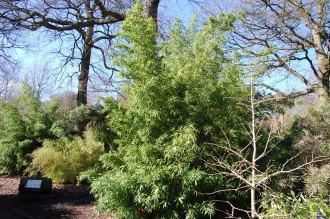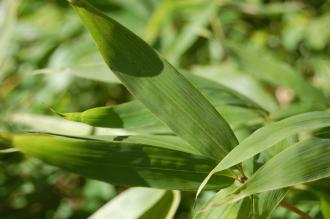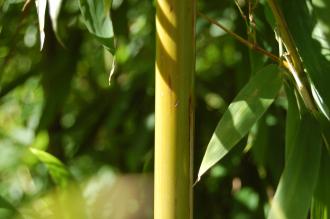
Phyllostachys aurea (01/03/15, Kew Gardens, London)
Position: Sun to light shade
Flowering Period: N/A
Soil: Moist, well drained
Eventual Height: 10m
Eventual Spread: 4m
Hardiness: 6b, 7a, 7b, 8a, 8b, 9a, 9b, 10a, 10b
Family: Poaceae
Phyllostachys aurea is an evergreen running bamboo with an upright habit. Its glossy light green leaves are linear with entire margins and are up to 12cm long and 20mm broad. Its light green to golden culms are up to 5cm in diameter. This plant produces underground rhizomes which aids its slow (not invasive in the UK) spread.

Phyllostachys aurea Leaf (01/03/15, Kew Gardens, London)
Phyllostachys aurea, commonly known as Fish Pole Bamboo or Golden Bamboo, is native to south east China. In its native habitat it grows at woodland edges and clearings. Phyllostachys aurea is synonymous with Bambusa aurea. This bamboo is considered an invasive plant in some parts of the USA.
The etymological root of the binomial name Phyllostachys is derived from the Greek phyllon meaning ‘leaf’ and stachys meaning ‘spike’. Aurea is from the Latin meaning ‘golden’.
The landscape architect may find Phyllostachys aurea useful as a useful as a tall screening bamboo. A root barrier may be used to contain its spread. Once established this bamboo is drought tollerant.
Ecologically, Phyllostachys aurea is of little wildlife value in the UK.

Phyllostachys aurea Cane (01/03/15, Kew Gardens, London)
The Royal Horticultural Society has given Phyllostachys aurea their prestigious Award of Garden Merit in 1993.
Phyllostachys aurea prefers moist, humus rich, well-drained soils. It tolerates most pH of soil.
Phyllostachys aurea requires little to no maintenance. The plant may be thinned out if required and spent canes may be cut back to the ground level. Its lower leaves may be removed to expose its attractive canes.

